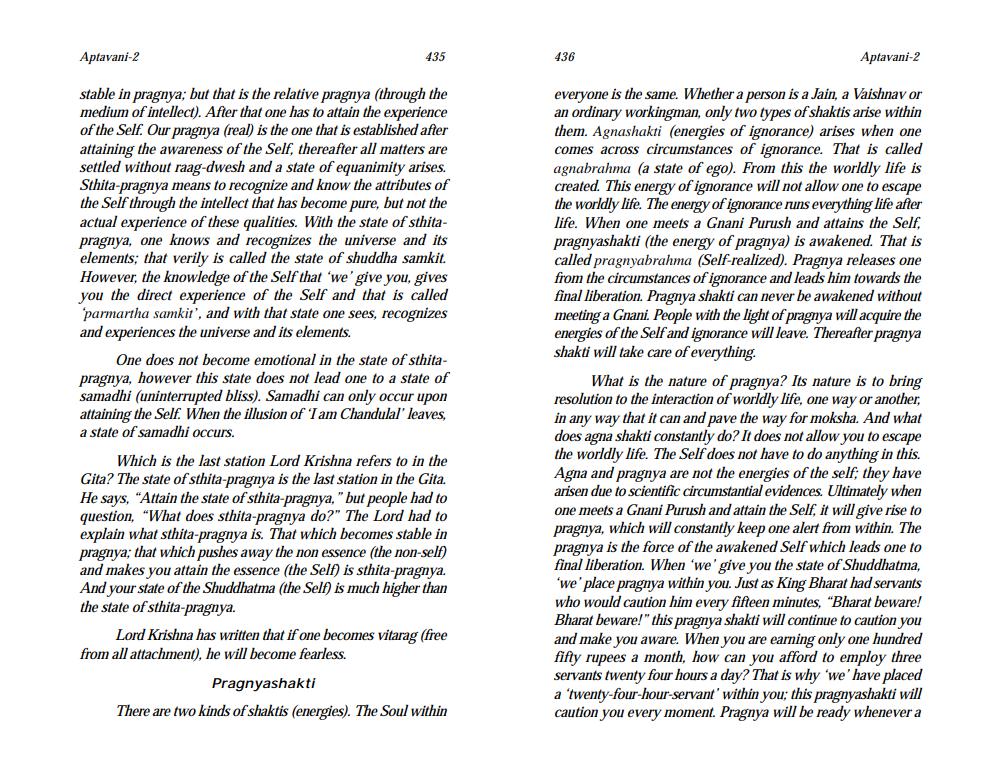________________
Aptavani-2
435
436
Aptavani-2
stable in pragnya; but that is the relative pragnya (through the medium of intellect). After that one has to attain the experience of the Self. Our pragnya (real) is the one that is established after attaining the awareness of the Self, thereafter all matters are settled without raag-dwesh and a state of equanimity arises. Sthita-pragnya means to recognize and know the attributes of the Self through the intellect that has become pure, but not the actual experience of these qualities. With the state of sthitapragnya, one knows and recognizes the universe and its elements; that verily is called the state of shuddha samkit. However, the knowledge of the Self that we give you, gives you the direct experience of the Self and that is called parmartha samkit', and with that state one sees, recognizes and experiences the universe and its elements.
One does not become emotional in the state of sthitapragnya, however this state does not lead one to a state of samadhi (uninterrupted bliss). Samadhi can only occur upon attaining the Self. When the illusion of 'I am Chandulal' leaves, a state of samadhi occurs.
Which is the last station Lord Krishna refers to in the Gita? The state of sthita-pragnya is the last station in the Gita. He says, "Attain the state of sthita-pragnya," but people had to question, "What does sthita-pragnya do?" The Lord had to explain what sthita-pragnya is. That which becomes stable in pragnya; that which pushes away the non essence (the non-self) and makes you attain the essence (the Self) is sthita-pragnya. And your state of the Shuddhatma (the Self) is much higher than the state of sthita-pragnya.
Lord Krishna has written that if one becomes vitarag (free from all attachment), he will become fearless.
everyone is the same. Whether a person is a Jain, a Vaishnav or an ordinary workingman, only two types of shaktis arise within them. Agnashakti (energies of ignorance) arises when one comes across circumstances of ignorance. That is called agnabrahma (a state of ego). From this the worldly life is created. This energy of ignorance will not allow one to escape the worldly life. The energy of ignorance runs everything life after life. When one meets a Gnani Purush and attains the Self, pragnyashakti (the energy of pragnya) is awakened. That is called pragnyabrahma (Self-realized). Pragnya releases one from the circumstances of ignorance and leads him towards the final liberation. Pragnya shakti can never be awakened without meeting a Gnani. People with the light of pragnya will acquire the energies of the Self and ignorance will leave. Thereafter pragnya shakti will take care of everything.
What is the nature of pragnya? Its nature is to bring resolution to the interaction of worldly life, one way or another, in any way that it can and pave the way for moksha. And what does agna shakti constantly do? It does not allow you to escape the worldly life. The Self does not have to do anything in this. Agna and pragnya are not the energies of the self; they have arisen due to scientific circumstantial evidences. Ultimately when one meets a Gnani Purush and attain the Self, it will give rise to pragnya, which will constantly keep one alert from within. The pragnya is the force of the awakened Self which leads one to final liberation. When we give you the state of Shuddhatma, 'we' place pragnya within you. Just as King Bharat had servants who would caution him every fifteen minutes, "Bharat beware! Bharat beware!" this pragnya shakti will continue to caution you and make you aware. When you are earning only one hundred fifty rupees a month, how can you afford to employ three servants twenty four hours a day? That is why 'we' have placed a 'twenty-four-hour-servant' within you; this pragnyashakti will caution you every moment. Pragnya will be ready whenever a
Pragnyashakti
There are two kinds of shaktis (energies). The Soul within




